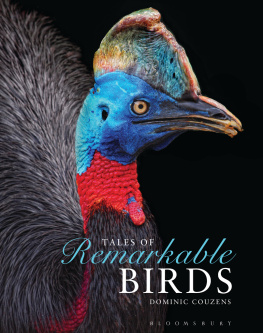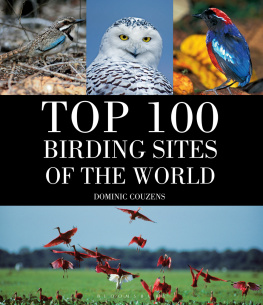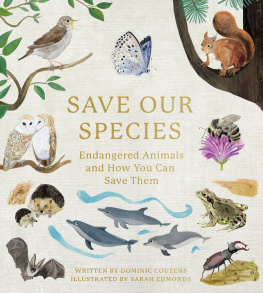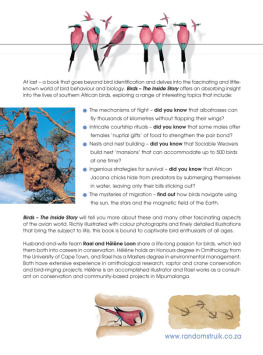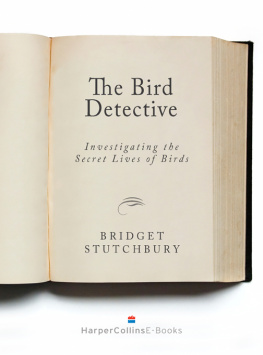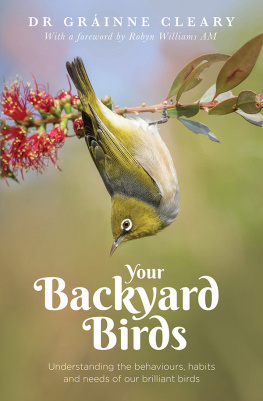Dominic Couzens has asserted his right under the Copyright, Designs and Patents Act, 1988, to be identified as Author of this work.
A catalogue record for this book is available from the British Library.
Page numbers refer to the print edition.
To find out more about our authors and books visit www.bloomsbury.com. Here you will find extracts, author interviews, details of forthcoming events and the option to sign up for our newsletters.

A Grey-headed Albatross protects its chick against the threat of a skua overhead.
INTRODUCTION
This book is a celebration of bird behaviour around the world. It is a small taster for a great feast. Birds do some extraordinary things, and to cover all their solutions to the trials of life would take many volumes. A taster is intended to whet the appetite, so the function of this book is really to entice the reader to find out more about what birds get up to around the world, by reading further books, trawling the internet or going into the field to watch. The next discoveries, after all, are often in the backyard.
How does one go about selecting some stories to reflect the diversity and complexity of avian lives? I have used three main criteria: a worldwide spread of stories, a spread of behaviours from across the spectrum of what birds do (migrating, feeding, incubating eggs, and so on), and my own personal preferences. I have tried to avoid what we in Britain call old chestnuts, stories that most people have already heard and will not come to fresh. As a result, some of those in this book are quite obscure, and I make no excuses for that.
This book is divided into eight sections to keep a wide geographic breadth of stories. Most sections cover genuinely biogeographical entities: North America (Nearctic), South America (Neotropical, which includes Central America), Africa south of the Sahara (Afrotropical), Australasia and the Antarctic. However, for convenience Europe is treated as an entity because of the high level of research traffic there, and one story from the Asian part of the Palearctic is included in the Asian section. Furthermore, the worlds Islands are treated in a section on their own.
Although the spread of stories largely reflects the wide spectrum of different bird behaviours, I have tried to cover themes that are relevant to the region, where this is possible. For example, the obligate following of army ant swarms is best developed in the Neotropics, and in Australia there is an unusual high percentage of group living birds. You might also argue that duetting is especially well developed in Africa, and that incubating an egg independently of a birds skin is virtually confined to Australasia and Oceania. Nevertheless, few behaviours have real geographical limits.
While a book on global bird behaviour needs a suitably complete geographic reach, it also needs to cover the main ornithological bases in regard to the different types of behaviour. It will never get near to complete, since within every division of bird biology (e.g. breeding), there are numerous subdivisions and subdivisions of subdivisions. Indeed, the sheer scope of behavioural research is simply overwhelming where do you start? In preparing this book I divided a birds life into its various compartments and made sure that, across the work, as many as possible were covered. Hopefully readers will find that their pet subject is included somewhere.
To give you an idea of the range of subjects covered, here is something of an alternative index to them, with the type of behaviour and the species or families concerned:
Roosting: Northern Wren (Europe), Varied Sittella (Australasia), Hummingbirds (South America)
Incubation: Rockhopper Penguin (Antarctic), Pheasant-tailed Jacana (Asia), Ostrich (Africa), Micronesian Scrubfowl (Island)
Nest-site: Marbled Murrelet (North America) Infanticide: Pheasant-tailed Jacana (Asia)
Group-living: White-winged Chough (Australasia), Arabian Babbler (Asia)
Vocalisations: Boubous/Gonolek (Africa), White-crowned Sparrow (North America)
Duetting: Boubous/Gonolek (Africa)
Pair-bonds: Fairywrens (Australasia), Great Grey Shrike (Europe), Albatrosses (Antarctic)
Sexual selection: Long-tailed Widowbird (Africa)
Display: Great Bowerbird (Australasia), Blue Bird-of-paradise (Islands)
Lek: Andean Cock-of-the-Rock (South America)
Brood parasitism: Great Spotted Cuckoo (Europe), Whydah/Grenadier (Africa)
Parental care: Pheasant-tailed Jacana (Asia), Rockhopper Penguin (Antarctic), Marbled Murrelet (North America)
Commensal feeding: Greater Racket-tailed Drongo (Asia)
Food-storing: Great Grey Shrike (Europe), Black-capped Chickadee (North America)
Resource partition: Oystercatcher (Europe), Tanagers (South America)
Communal foraging: Harriss Hawk (North America)
Optimal foraging: Swallow-tailed Gull (Islands)
Ant-following: Antbirds (South America)
Scavenging: Sheathbills (Antarctic)
Nest-robbing: Toucans (South America)
Mobbing: Greater Racket-tailed Drongo (Asia)
Evolution in action: Sunbirds (Africa), Cliff Swallows (North America)
Comparative ecology: Tanagers (South America), Penguins (Antarctic)
Memory: Black-capped Chickadee (North America)
Intelligence: New Caledonian Crow (Islands)
Echolocation: Swiftlets (Asia)
Flight style: Hummingbirds (South America), Albatrosses (Antarctic)
Footed-ness: Crossbill (Europe)
Physical intimidation: Toucans (South America)
Migration: Yellow-browed Warbler (Asia), Albatrosses (Antarctic)

